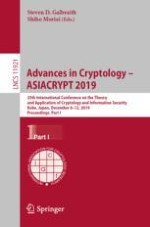2019 | OriginalPaper | Buchkapitel
Divisible E-Cash from Constrained Pseudo-Random Functions
verfasst von : Florian Bourse, David Pointcheval, Olivier Sanders
Erschienen in: Advances in Cryptology – ASIACRYPT 2019
Aktivieren Sie unsere intelligente Suche, um passende Fachinhalte oder Patente zu finden.
Wählen Sie Textabschnitte aus um mit Künstlicher Intelligenz passenden Patente zu finden. powered by
Markieren Sie Textabschnitte, um KI-gestützt weitere passende Inhalte zu finden. powered by
